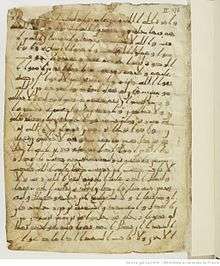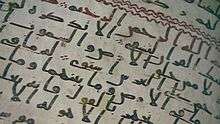Early Quranic manuscripts
In Muslim tradition the Quran is a final revelation from God, Islam’s divine text,[1] delivered to the Prophet of Islam Muhammad, through the angel Jabreel (Gabriel). Muhammad’s revelations were said to have been recorded orally and in writing, through Muhammad and his followers up until his death in 632,[1] and then compiled by first caliph Abu Bakr and codified during the reign of the third caliph Uthman (r. 644–656) so that the standard codex edition of the Quran or "Muṣḥaf" was completed around 650 CE, according to Muslim scholars.[2] However, some Western scholars (John Wansbrough) have questioned this, suggesting the Quran was canonized at a later date, based on the fact that the classical Islamic narratives were written generations—150 to 200 years—after the death of Muhammad.[3]
According to Corpus Coranicum, a research organisation funded by the Government of Germany, more than 60 fragments including more than 2000 folios (4000 pages) are so far known as the textual witnesses (manuscripts) of the Qur’an before 800 CE (within 168 years after the death of Prophet Muhammad).[4] However, in 2015, experts from the University of Birmingham UK introduced a manuscript which is possibly the oldest manuscript of the Quran in the world. Radiocarbon tests to determine the age of the manuscript revealed that this manuscript could be traced back to between 6th or 7th century (between 568 and 645 CE).[5][6][7] Selected manuscripts from the first four centuries after the death of Muhammad (632-1032 CE) are listed below.
Hijazi manuscripts


Hijazi manuscripts are some of the earliest forms of Quranic texts, and can be characterized by Hijazi script.[1] Hijazi script is distinguished by its "informal, sloping Arabic script."[8] The most widely used Qurans were written in the Hijazi style script, a style that originates before Kufic style script. This is portrayed by the rightward inclining of the tall shafts of the letters, and the vertical extension of the letters.[9]
Sana'a manuscript
The Sana'a manuscript, is one of the oldest Quranic manuscripts in existence. It contains only three chapters. It was found, along with many other Quranic and non-Quranic fragments, in Yemen in 1972 during restoration of the Great Mosque of Sana'a. The manuscript is written on parchment, and comprises two layers of text (see palimpsest). The upper text conforms to the standard 'Uthmanic Quran, whereas the lower text contains many variants to the standard text. An edition of the lower text was published in 2012.[10] A radiocarbon analysis has dated the parchment containing the lower text to before 671 AD with a 99% accuracy.[11]
Codex Parisino-petropolitanus
The so-called Codex Parisino-petropolitanus formerly conserved portions of two of the oldest extant Quranic manuscripts. Most surviving leaves represent a Quran that is preserved in various fragments, the largest part of which are kept in the Bibliothèque nationale de France, as BNF Arabe 328(ab). 46 leaves are held at the National Library of Russia and one each in the Vatican Library and in the Khalili Collections.
BnF Arabe 328(c) and Birmingham fragment

BnF Arabe 328(c), formerly bound with BnF Arabe 328(ab), has 16 leaves,[12] with two additional leaves discovered in Birmingham in 2015 (Mingana 1572a, bound with an unrelated Quranic manuscript).[13] [14]
This manuscript may date to the mid-7th century: The parchment of the Birmingham fragment has been carbon-dated to between 568 and 645 with a confidence of 97.2%, indicating the animal from which the parchment was made lived during that time.
BnF Arabe 328(c) was part of the lot of pages from the store of Quranic manuscripts at the Mosque of Amr ibn al-As in Fustat bought by French Orientalist Jean-Louis Asselin de Cherville (1772–1822) when he served as vice-consul in Cairo during 1806–1816.
The 16 folia in Paris contain the text of sura 10:35 to 11:95 and of 20:99 to 23:11. The Birmingham folia cover part of the lacuna in the Paris portion, with parts of the text of suras 18, 19 and 20. The text is laid out in the format that was to become standard for complete Quran texts, with chapter divisions indicated by linear decoration, and verse endings by intertextual clustered dots.
Tübingen fragment
In November 2014, the University of Tübingen in Germany announced that a partial Quran manuscript in their possession (Ms M a VI 165), had been carbon dated (with a confidence of 95%), to between 649 and 675.[15][16][17][18] The manuscript is now recognised as being written in hijazi script, although in the 1930 catalogue of the collection it is classified as "Kufic", and consists of the Quranic verses 17:36, to 36:57 (and part of verse 17:35).[19]
Add. 1125
This manuscript was acquired by University of Cambridge from Edward H. Palmer (1840-1882) and EE Tyrwhitt Drake.[20] It was created before 800CE according to Corpus Coranicum.[20]
Kufic manuscripts
Kufic manuscripts can be characterized by the Kufic form of calligraphy. Kufic calligraphy, which was later named after art historians in the 19th or 20th century is described by means of precise upstanding letters. For a long time, the Blue Qur'an, the Topkapi manuscript, and the Samarkand Kufic Quran were considered the oldest Quran copies in existence. Both codices are more or less complete. They are written in the Kufic script. It "can generally be dated from the late eighth century depending on the extent of development in the character of the script in each case."[21]
The Blue Quran
The Blue Qur'an (Arabic: المصحف الأزرق al-Muṣḥaf al-′Azraq) is a late 9th to early 10th-century Fatimid Tunisian Qur'an manuscript in Kufic calligraphy, probably created in North Africa for the Great Mosque of Kairouan.[22] It is among the most famous works of Islamic calligraphy,[22] and has been called "one of the most extraordinary luxury manuscripts ever created."[23] Because the manuscript was done in Kufic style writing, it is quite hard to read. "The letters have been manipulated to make each line the same length, and the marks necessary to distinguish between letters have been omitted."[24] The Blue Quran is constructed of indigo-dyed parchment with the inscriptions done in gold ink, which arguably makes it one of the most rare Quran productions ever known.[24] The use of dyed parchment and gold ink is said to have been inspired by the Christian Byzantine Empire, due to the fact that many manuscripts were produced in the same way there.[24] Each verse is separated by circular silver marks, although they are now harder to see due to fading and oxidization.[24]


Topkapi manuscript
The Topkapi manuscript is an early manuscript of the Quran dated to the early 8th century. This manuscript is kept in the Topkapi Palace Museum, Istanbul, Turkey. It was wrongly attributed to Uthman Ibn Affan (d. 656), but judging from its illumination, the Topkapi manuscript does not date from the period (mid 7th century) when the copies of the Caliph Uthman were written.[25]
Samarkand Kufic Quran
The Samarkand Kufic Quran, preserved at Tashkent, is a Kufic manuscript, in Uzbek tradition identified as one of Uthman's manuscripts, but dated to the 8th or 9th century by both paleographic studies and carbon-dating of the parchment.[26][27] Radio-carbon dating showed a 95.4% probability of a date between 795 and 855.[27]
Gilchrist's dating of any Kufic manuscript to the later 8th century has been criticized by other scholars, who have cited many earlier instances of early Kufic and pre-Kufic inscriptions. The most important of these are the Quranic inscriptions in Kufic script from the founding of the Dome of the Rock in Jerusalem (692).[28] Inscriptions on rock Hijazi and early Kufic script may date as early as 646. The debate between the scholars has moved from one over the date origin of the script to one over the state of development of the Kufic script in the early manuscripts and in datable 7th-century inscriptions.
Gotthelf Bergsträßer Archive
This almost complete Quranic manuscript was photographed by Otto Pretzl in 1934 in Morocco. In recent years, a few folios from the manuscripts have been sold by private companies and were dated to the 9th century or earlier by Christie's.[29][30]
Other Manuscripts
The Ma'il Quran
The Ma'il Quran is an 8th-century Quran (between 700 and 799) originated from Saudi Arabia. It contains two-thirds of the Qur’ān text and is one of the oldest Qur’āns in the world.[31] It is now kept in The British Library.
References
- Cohen, Julia (2014). "Early Qur'ans (8th-Early 13th Century)". The Met Museum.
- Cook, The Koran, 2000: p.6
- Berg , "Methods and Theories of John Wansbrough", 2000: p.495
- Its official website says : "Mehr als 60 Fragmente mit insgesamt mehr als 2000 Blättern (4000 Seiten) sind als Textzeugen für den Koran vor 800 bisher bekannt." https://corpuscoranicum.de/
- "Birmingham Qur'an manuscript dated among the oldest in the world". University of Birmingham. 22 July 2015. Retrieved 22 July 2015.
- "'Oldest' Koran fragments found in Birmingham University". BBC. 22 July 2015. Retrieved 22 July 2015.
- University of Birmingham. 22 July 2015 https://web.archive.org/web/20150722212055/https://www.birmingham.ac.uk/news/latest/2015/07/quran-manuscript-22-07-15.aspx. Archived from the original on 22 July 2015. Retrieved 31 October 2019. Missing or empty
|title=(help) - Hannah, Korn (2012). "Scripts in Development". Metmuseum.org.
- Blair, Sheila (1998). Islamic Inscriptions. New York University.
- Sadeghi, Behnam; Goudarzi, Mohsen (2012). "Ṣan'ā' 1 and the Origins of the Qur'ān". Der Islam. 87 (1–2): 1–129. doi:10.1515/islam-2011-0025.CS1 maint: ref=harv (link)
- Sadeghi, Behnam; Bergmann, Uwe (2010). "The Codex of a Companion of the Prophet and the Qurʾān of the Prophet". Arabica. 57 (4): 343–436. doi:10.1163/157005810X504518.CS1 maint: ref=harv (link)
- "Coran" – via gallica.bnf.fr.
- "Birmingham Qur'an manuscript dated among the oldest in the world". University of Birmingham. 22 July 2015. Retrieved 22 July 2015.
- "'The Qur'anic Manuscripts of the Mingana Collection and their Electronic Edition'". Quranic Studies Association Blog. 18 March 2013. Retrieved 23 July 2015.
- "Tübingen University fragment written 20-40 years after the death of the Prophet, analysis shows". Eberhard Karls Universität Tübingen. February 15, 2016. Retrieved January 3, 2017.
- Sensational Fragment of Very Early Qur’an Identified
- "M a VI 165 – A Qur'anic Manuscript From The 1st Century Hijra At The Universitätsbibliothek Tübingen, Germany". www.islamic-awareness.org.
- "World's oldest Qur'an found in Germany". Iran Daily. Retrieved January 3, 2017.
- "Kufisches Koranfragment". Universität Tübingen. Retrieved January 3, 2017.
- https://corpuscoranicum.de/handschriften/index/sure/8/vers/10/handschrift/282
- John Gilchrist, Jam' al-Qur'an: The codification of the Qur'an text (1989), p. 146.
- "Folio from the Blue Qur'an (Probably North Africa (Tunisia)) (2004.88)". Heilbrunn Timeline of Art History. New York: The Metropolitan Museum of Art. September 2012. Retrieved 28 April 2013.
- "Folio From the Blue Qur'an". Brooklyn Museum. Retrieved 28 April 2013.
- "Folio from the "Blue Qur'an"".
- "The "Qur'ān Of ʿUthmān" At The Topkapi Museum, Istanbul, Turkey, From 1st / 2nd Century Hijra". Islamic Awareness. 2008-07-19. Retrieved 2011-10-05.
- "The "Qur'ān Of ʿUthmān" At Tashkent (Samarqand), Uzbekistan, From 2nd Century Hijra". Retrieved 2013-09-13.
- E. A. Rezvan,"On The Dating Of An “'Uthmanic Qur'an” From St. Petersburg", Manuscripta Orientalia, 2000, Volume 6, No. 3, pp. 19-22.
- The Arabic Islamic Inscriptions On The Dome Of The Rock In Jerusalem, islamic-awareness.org; also Hillenbrand, op. cit.
- https://www.christies.com/lotfinder/books-manuscripts/a-kufic-quran-folio-near-east-or-5421825-details.aspx?from=salesummary&pos=1&intObjectID=5421825&sid=a6032625-c485-4814-9f77-b1aaa8b0fbc6&page=1&lid=1
- https://www.christies.com/lotfinder/books-manuscripts/a-kufic-quran-folio-near-east-or-5826190-details.aspx?pos=1&intObjectID=5826190&sid=&page=14&lid=1
- https://blogs.bl.uk/asian-and-african/2016/04/the-british-librarys-oldest-quran-manuscript-now-online.html
- Berg, Herbert (2000). "15. The Implications of, and Opposition to, the Methods and Theories of John Wansbrough". The Quest for the Historical Muhammad. New York: Prometheus Books. pp. 489–509.
- Cook, Michael (2000). The Koran : A Very Short Introduction. Oxford University Press. ISBN 0192853449.
- Wansbrough, J. (1978). Quranic Studies: Sources and Methods of Scriptural Interpretation (PDF). Oxford. Retrieved 27 February 2020.
See also
- History of the Quran
- Corpus Coranicum
- Hadith Manuscripts